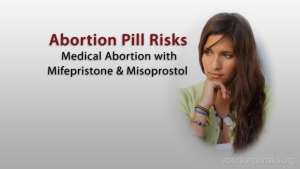Undiagnosed Ectopic Pregnancy
HEALTH RISKS: MEDICAL ABORTION UNDIAGNOSED ECTOPIC PREGNANCY
 |
What Are The Risks?
Learn About The Complications of a Ruptured Ectopic Pregnancy Following Medical Abortion.
|
On This Page:
ECTOPIC PREGNANCY
What is an ectopic pregnancy?
Ectopic pregnancy is any pregnancy that develops outside of the uterine cavity. It occurs in approximately 2% of all pregnancies. The ectopic pregnancy is usually located in one of the fallopian tubes. As the fetus grows, it damages the tube, causing it to rupture (burst) and bleed. (1)
Ectopic pregnancy is a preexisting condition rather than a complication of the medical abortion procedure. (2)
Unless they are discovered and treated early, almost 40% of ectopic pregnancies rupture suddenly, causing pain and dangerous bleeding in the abdominal cavity. The other 60% usually cause slow bleeding in the abdomen. Ruptured ectopic pregnancies can be fatal. (1)
Mifepristone medical abortion is contraindicated in patients with ectopic pregnancies as the treatment procedure will not be effective to terminate this type of pregnancy. (3) (see CONTRAINDICATIONS and WARNINGS)
Ectopic pregnancy is a common condition with significant health consequences; complications are a major cause of maternal mortality in the United States. Accurate ascertainment of the number of ectopic pregnancies occurring in the United States has been dramatically affected by changing medical practices, causing estimates based on hospital data to be falsely low. (4)
UNDIAGNOSED ECTOPIC PREGNANCY
What is an undiagnosed ectopic pregnancy?
Ectopic pregnancy may be diagnosed when a woman seeking a medical abortion undergoes clinical assessment before the procedure. (2)
An undiagnosed ectopic pregnancy is one that can go undetected during clinical assessment and even remain undetected after a medical abortion is performed. (2)
The presence of an ectopic pregnancy may have been missed even if the patient underwent ultrasonography prior to being prescribed Mifeprex (mifepristone) for medical abortion. (3)
UNDIAGNOSED ECTOPIC PREGNANCY COMPLICATIONS
What symptoms are possible complications of an undiagnosed ectopic pregnancy?
Patients who have abdominal pain or discomfort, or may be “feeling sick”, including weakness, nausea, vomiting or diarrhea, with or without fever, more than 24 hours after taking misoprostol, should contact their provider without delay. These symptoms may be a sign of a serious infection or another problem (including an ectopic pregnancy, a pregnancy outside the womb). (5) (See WARNINGS)
Patients who are undergoing medical abortion could have an undiagnosed ectopic pregnancy since some of the expected symptoms of a medical abortion may be similar to those of a ruptured ectopic pregnancy. (3)
Typical symptoms of ectopic pregnancy are abdominal or pelvic pain—often one-sided— and vaginal bleeding. Pain and bleeding may be persistent or erratic and, in some cases, absent. (2)
The U.S. Food and Drug Administration (FDA) reported two cases of women who have died from undiagnosed ectopic pregnancy following mifepristone and misoprostol medical abortion. (6) (See DEATH)
1. U.S. Department of Health & Human Services. Drugs, Mifeprex Questions and Answers, 2/24/2010. FDA, U.S. Food and Drug Administration. [Online] February 24, 2010. [Cited: July 16, 2011.] http://www.fda.gov/Drugs/DrugSafety/PostmarketDrugSafetyInformationforPatientsandProviders/ucm111328.htm.
2. Medabon. Guidelines for Providers of Emergency Care. Medabon. [Online] 2009. [Cited: September 24, 2011.] http://www.medabon.info/guidelines.php.
3. U.S. Department of Health & Human Services. Drugs@FDA, Mifeprex (mifepristone) Label and Approval History. FDA, U.S. Food and Drug Administration. [Online] April 27, 2009. [Cited: July 12, 2011.] http://www.accessdata.fda.gov/scripts/cder/drugsatfda/index.cfm?fuseaction=Search.Label_ApprovalHistory.
4. Zane, Suzanne B, et al., et al. Surveillance in a time of changing health care practices: estimating ectopic pregnancy incidence in the United States, Maternal and Child Health Journal, Vol 6 (4), 227-236. NCBI, PubMed. [Online] December 6, 2002. [Cited: September 24, 2011.] http://www.ncbi.nlm.nih.gov/pubmed/12512764. DOI: 10.1023/A:1021106032198.
5. U.S. Department of Health & Human Services. Drugs, Labeling and Regulatory History from Drugs@FDA, Mifeprex (mifepristone) Medication Guide, Rev 3: 4/22/09. FDA, U.S. Food and Drug Administration. [Online] July 19, 2011. [Cited: July 20, 2011.] http://www.fda.gov/downloads/Drugs/DrugSafety/UCM088643.pdf.
Page Last Updated: 9/24/2011



Comments on this entry are closed.